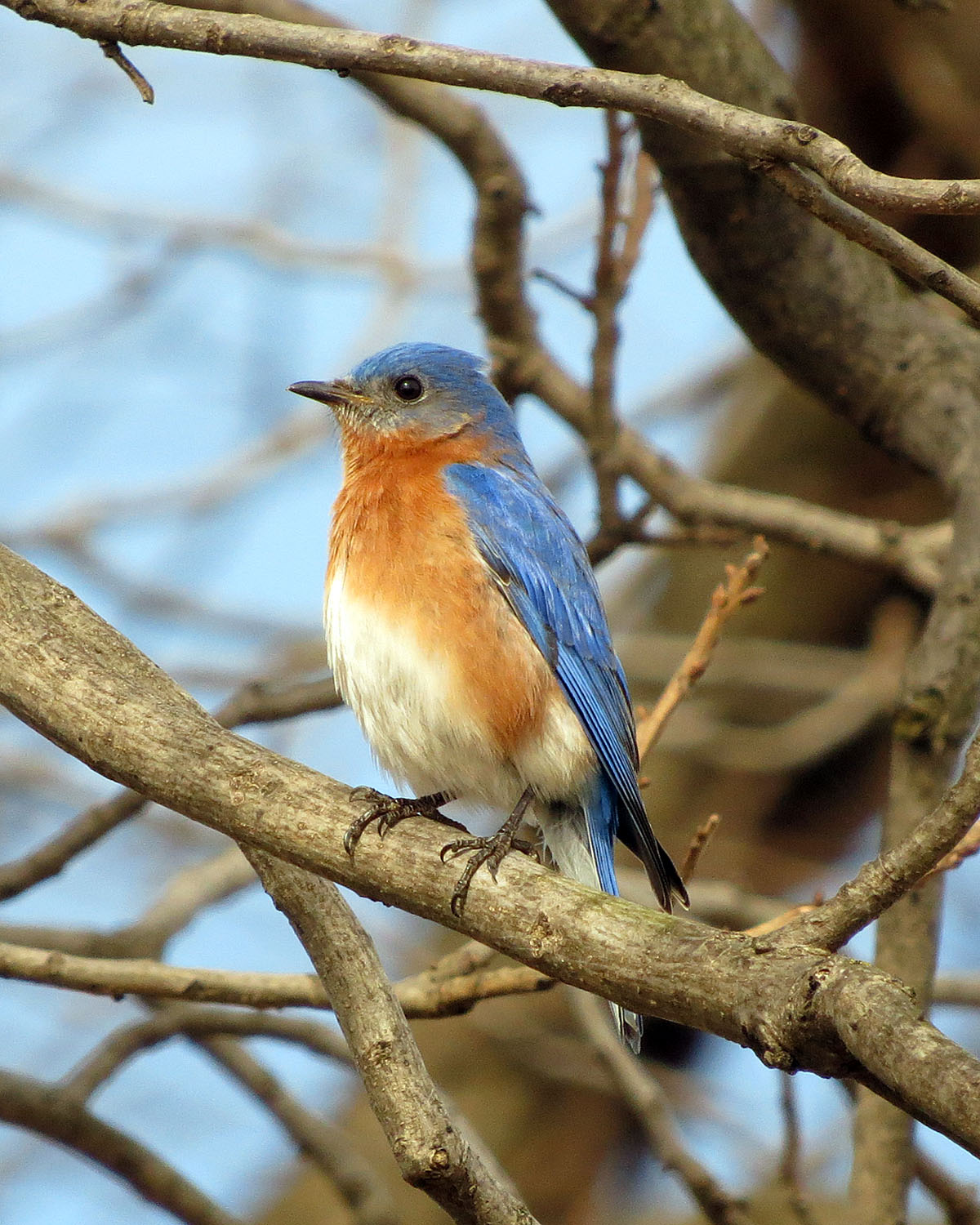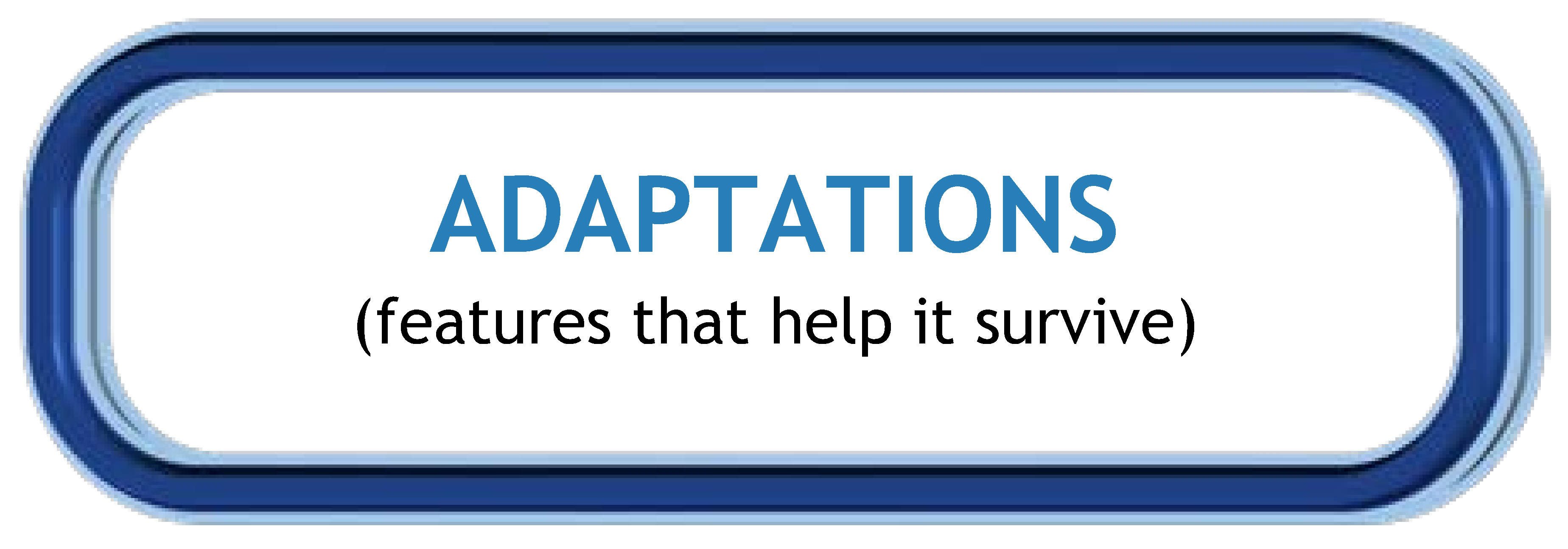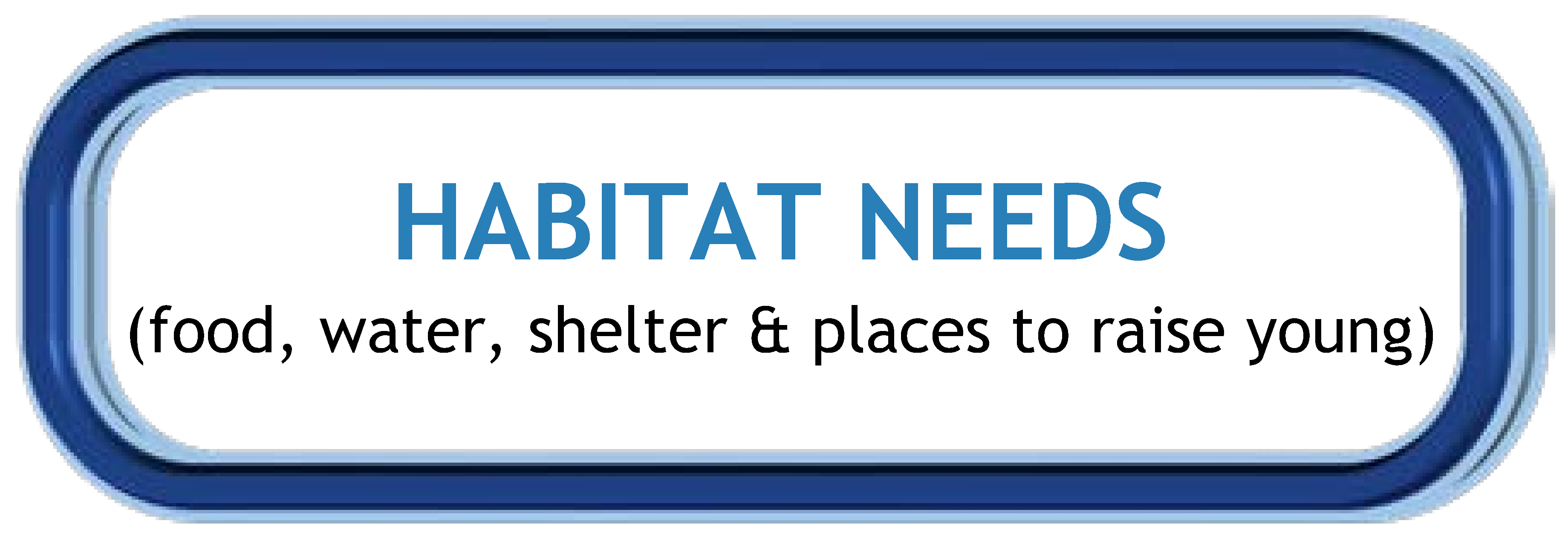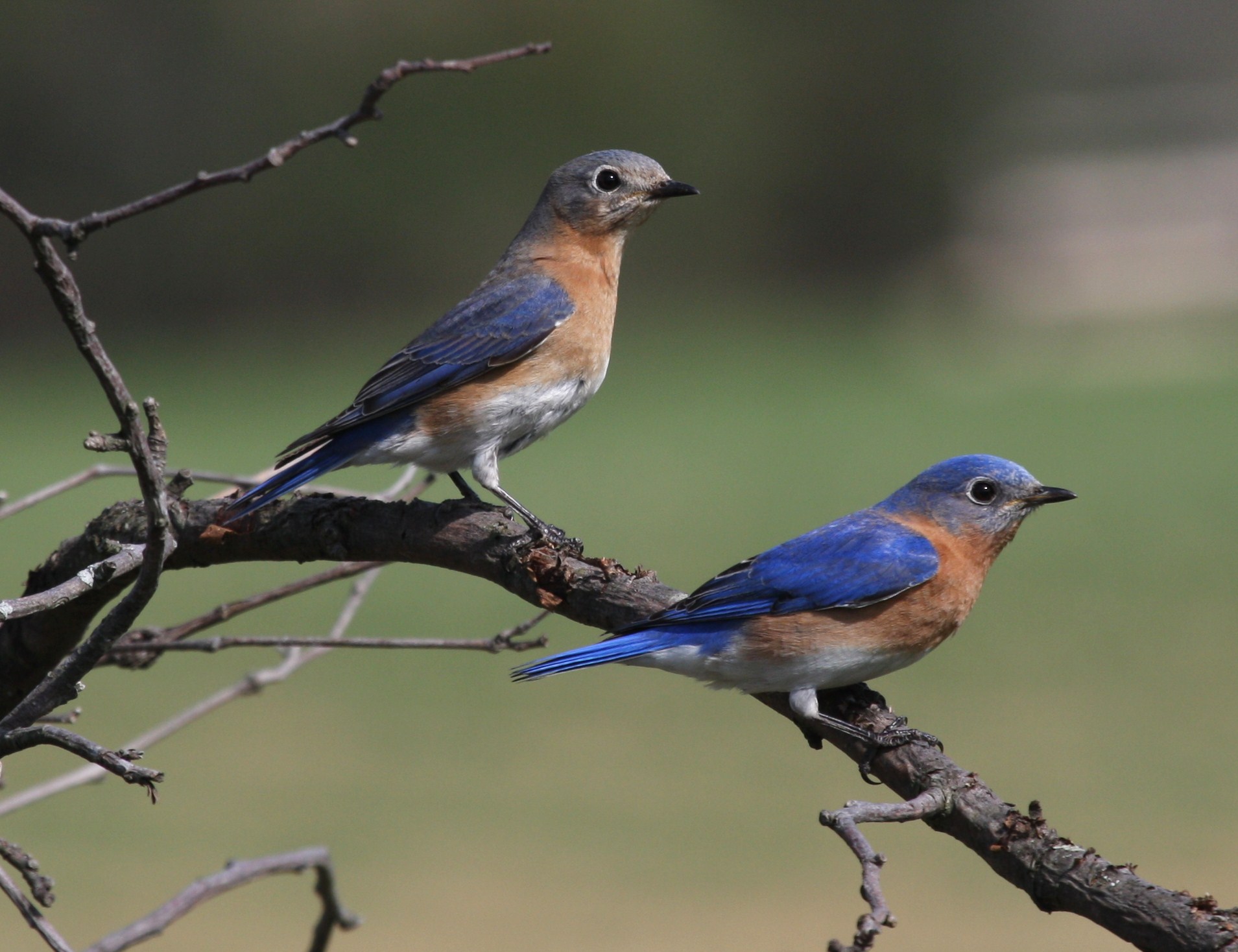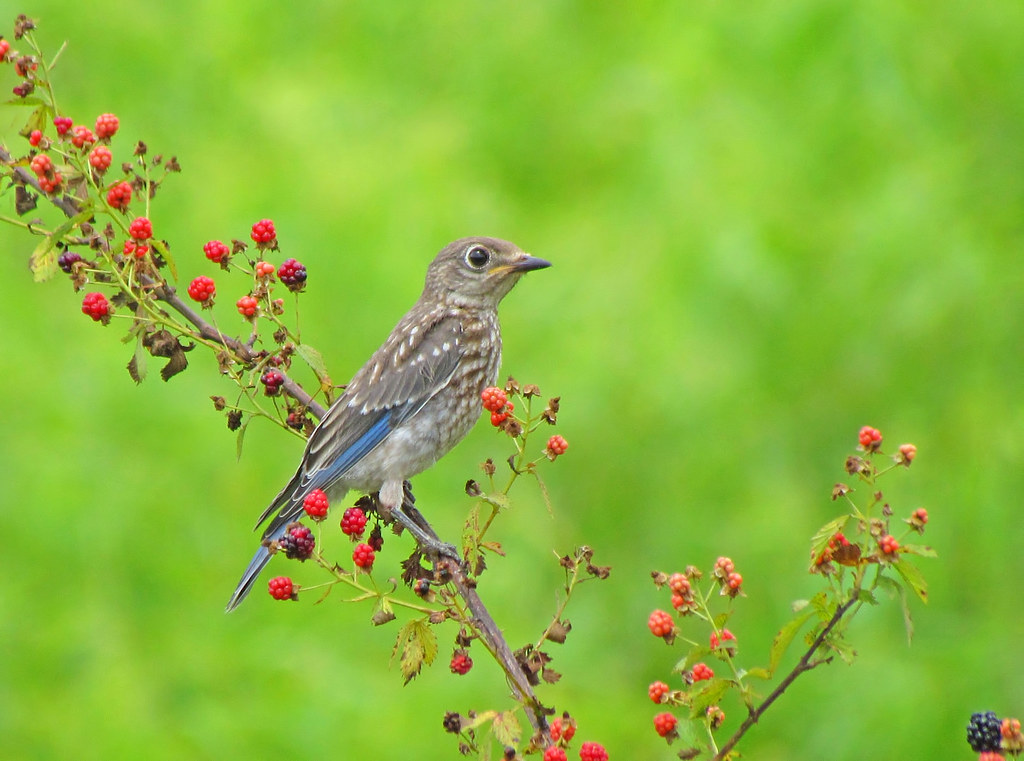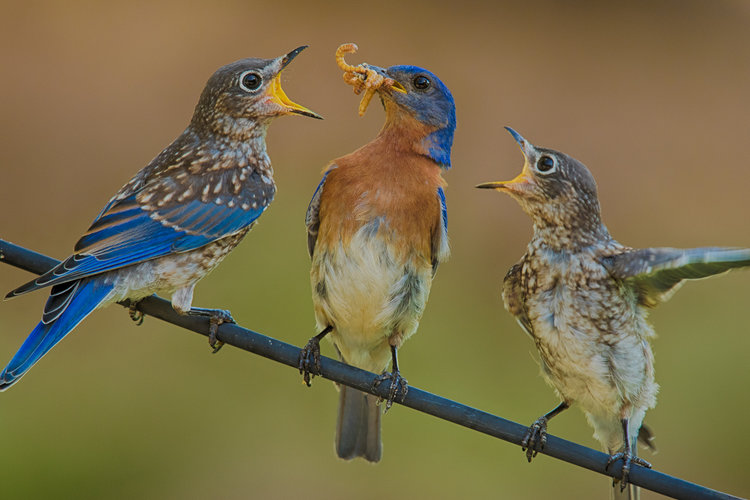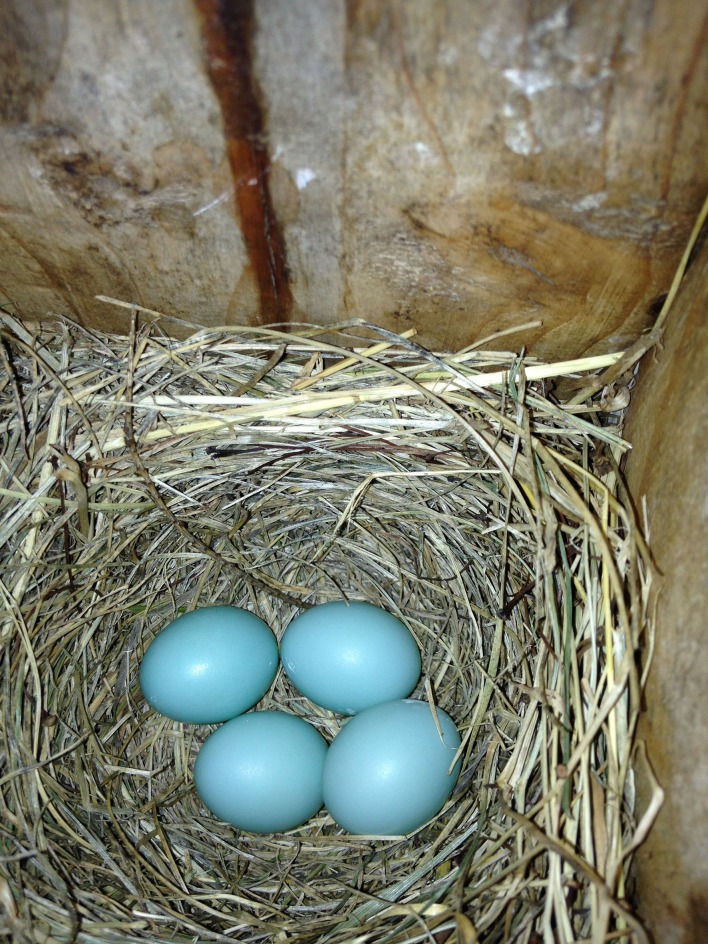Wonders of Wildlife: Eastern Bluebird
Eastern Bluebird
Scientific Name: Sialia sialis
Found in Alabama: Year-round, statewide
Diet: Omnivore (eats plants and animals)
Learn more about... |
|
Eastern Bluebird in Habitat
Wikimedia - Don Faulkner |
| CLASSIFICATION |
| |
|
What type of animal am I?
- I am a vertebrate (an animal with a spine or backbone).
- I am warm-blooded, so I can control my body temperature.
- I have feathers on the outside of my body that keep me warm.
- I breathe with lungs just like you.
- I have 2 legs.
- I have wings.
|
Scientists use basic traits to group animals into different taxonomic classes.
For a taxonomic classification chart comparing key traits of common backyard wildlife,
CLICK HERE! |
|
| The Eastern Bluebird is a BIRD! |
| IDENTIFICATION TIPS |
| |
|
|
Size:
|
- range in length from 6 - 8 inches in length
- Weigh around 1 ounce
- Wingspan ranges from 9.8 - 12.6 inches
|
| |
|
|
Key
Characteristics:
|
- Bright blue coloration on the back
- Rusty coloration on the chest
- Males are brigher blue in coloration than females
- Females are more grey in coloration on the back
- Plump body, round head, and short tail
|
Male and Female Eastern Bluebird
Wikimedia - Sandysphotos2009
Click image to enlarge it |
| |
|
|
Young: |
- Similar in appearane to adults but appear more dull or brown in coloration
- Light spotting on the back and dusky spotting below
- Juvenile males have more blue in the wings and tail than juvenile females
|
Juvenile Eastern Bluebird
flickr - Vicki DeLoach
Click image to enlarge it |
| ADAPTATIONS |
| |
| PHYSICAL ADAPTATIONS |
| |
| Eastern bluebirds catch insects near the ground: |
- Eastern bluebirds often sit on perches where they can look out for insect prey.
- They have incredibly good eyesight and are able to spot insects on the ground from distances over 100 feet.
- Once an insect is spotted, they fly close to the ground and use their short, straight bill to catch the insect.
|
Adult Eastern Bluebird Feeding Babies
Menke Dave, USFWS
Click image to enlarge it
|
| |
| Birds can fly: |
- Birds have feathers on their wings rather than hair like humans. Feathers are light, waterproof, and are adjustable for flight control.
- Birds have lightweight beaks instead of heavy jaws and teeth like humans.
- Most bones in their bodies are hollow or honeycombed, making them very lightweight. Some of their bones are fused for increased efficiency and lighter weight.
- Birds have a larger and more efficient respiratory system than humans do since flight is a physically-demanding activity.
|
| |
| Birds can digest whole prey: |
- Birds do not have teeth and are not able to chew food. Because of this, they have a specialized part of their stomach, called a gizzard, that helps with digestion by grinding food.
- The small stones, sand, and grit that birds pick up while they are eating are stored in the gizzard.
- Once food is swallowed and makes its way to the gizzard, it is pulverized by the grit and stomach muscles.
- Some birds like chickens, ducks, and turkeys have thick, muscular gizzards. Other birds that eat food items that are easy to digest, such as nectar and soft-bodied insects, have thin-walled gizzards.
|
| |
| BEHAVIORAL ADAPTATIONS |
| |
| Eastern bluebirds are diurnal: |
- They are active during the day (diurnal).
|
| |
| Eastern bluebirds are territorial: |
- Male eastern bluebirds compete with other eastern bluebirds for resources.
- They will physically fight using their beaks, feet, and wings.
- They also compete with other types of birds for similar resources.
- Males are likely to attack other types of birds for nest sites.
- Females are likely to attack other types of birds that use similar food resources.
- If an eastern bluebird spots a threat, they make an alarm call, different from their more common song.
- They may also sometimes fly towards the predator (animal that eats them) or threatening animal.
|
| LIFE CYCLE |
| |
|
|
| Life Cycle Stages of the Eastern Bluebird |
| |
|
|
Nest: |
- Female builds a cup-shaped nest made of grass, pine needles, and other natural materials.
- They often line the nest with fine grasses or other soft materials like hair or feathers.
- The nest is built within a natural cavity.
|
Eastern Bluebird Nest and Eggs
Wikipedia - Bailey, R., Clark, G.
Click image to enlarge it |
| |
|
Eggs: |
- Females lay 2 - 7 hard-shelled eggs per brood.
- Each egg is pale blue in color and is less than an inch long.
- They have 1 - 3 broods per year, often overlapping.
|
| |
|
|
| Young: |
- Babies hatch from the eggs after 11 - 19 days.
- When they hatch, they do not have any feathers aside from a few tufts of soft, gray down feathers.
- They grow in their first set of feathers within 12 - 14 days and leave the nest after 17 - 21 days.
|
| |
|
|
| Life Span: |
|
NATURAL
Habitat Needs |
ADULTS |
YOUNG |
| Food |
- In warmer months, they eat caterpillars, moths, crickets, beetles, grasshoppers, spiders, and earthworms.
- In colder months, they eat fruits from native plants including blueberries, sumac, dogwood berries, honey suckle, and juniper berries.
|
- Both parents provide non-regurgitated (whole) food items including caterpillars, grasshoppers, crickets, beetles, spiders, and some fruits including mulberry, raspberry, and dogwood.
- They are fed by the parents for 3-4 weeks after leaving the nest.
|
| Water |
- They prefer to drink from streams or other sources of running water but will also drink from ponds.
|
- Food sources provide most of the hydration they need.
- They will drink from streams and ponds once they have fledged (left) from the nest.
|
| Shelter |
- Live in open grassland habitats with some trees.
|
- Nests are built in natural cavities in dead trees or created by woodpeckers.
- Young remain in the nest for up to 3 weeks until they can care for themselves.
|
| Places to Raise Young |
- Build nests in natural cavities in dead trees or old woodpecker holes.
|
|
BACKYARD
Habitat Needs |
ADULTS |
YOUNG |
| Food |
- Plant native plants such as dogwood, honeysuckle, juniper, and blueberry bushes.
- Provide bird feeders with mealworms.
- Do not remove moist, decaying logs because they help support invertebrates (animals withoug a spine or backbone) like beetles, earthworms, and spiders.
- Do not spray pesticides that might harm insect populations.
|
Provide food sources for the parents, as they feed the young. |
| Water |
- Provide a birdbath if a stream or pond is not located nearby.
|
| Shelter |
- Create open habitat with few trees.
- Provide a bluebird nest box.
|
- Leave tree snags (dead or dying trees) with natural cavities.
- Provide a bluebird nest box.
|
| Places to Raise Young |
- Leave tree snags (dead or dying trees) that provide opportunities for woodpecker holes.
- Provide bluebird boxes, specifically structured for bluebirds which provide nesting sites for them.
|
|
| ECOLOGICAL ROLE |
| |
|
| Animals play an important ecological role in the health of habitats and ecosystems. |
| |
|
Food Source: |
- Adult eastern bluebirds are eaten by American kestrels, European starlings, black rat snakes, black racers, raccoons, and black bears.
- Eastern bluebird eggs are often eaten by small mammals including eastern chipmunks and flying squirrels.
|
Predation by cats is the number one direct, human-caused threats to birds in the U.S. and Canada. In the U.S., as many as 2.4 billion birds are killed by cats each year. To read more about this,
CLICK HERE! |
|
| |
|
Insect Control: |
- Eastern bluebirds have an effect on the populations of the invertebrates that they use as a food source.
|
| |
|
Seed Dispersal: |
- Birds that eat fruits are responsible for spreading the seeds of the plants that they came from.
- Sometimes birds simply carry the seed away from the tree before dropping it.
- More often, after birds eat fruits and berries, they poop them out, covered in a natural fertilizer.
- This helps new plants grow in a location away from the parent plant.
- This form of seed dispersal (movement of seeds) is an important part of plant reproduction and survival.
|
INFORMATION SOURCES FOR THIS SPECIES
.
 Wildlife Tag
Wildlife Tag
